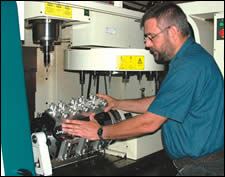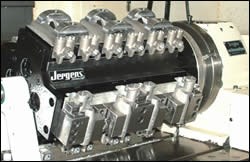Tightening Inventory And Setups
Producing three models of spray guns with differing machining requirements translated to 2 1/2 -day-long setups, not to mention the additional stress of not being able to keep up with production. All of that changed for the better, however, when a Columbus, Ohio industrial equipment manufacturer investigated alternate workholding products. Using a twin-station vise with machinable soft jaws, Rimrock Corporation eliminated continual refixturing while improving cycle times by 60 percent and reducing actual manned labor hours-to the tune of 50 percent.
Share




Producing three models of spray guns with differing machining requirements translated to 2 1/2 -day-long setups, not to mention the additional stress of not being able to keep up with production. All of that changed for the better, however, when a Columbus, Ohio industrial equipment manufacturer investigated alternate workholding products. Using a twin-station vise with machinable soft jaws, Rimrock Corporation eliminated continual refixturing while improving cycle times by 60 percent and reducing actual manned labor hours—to the tune of 50 percent.
Rimrock opened up shop in 1956. The company is comprised of about 110 employees, and it currently has two sister companies—one in New Berlin, Wisconsin, and another in Fort Collins, Colorado. Originally a producer of automatic lubrication systems, the company expanded its expertise to supply ladles, sprayers, extractors and complete turnkey robotic systems. As an exclusive integrator for ABB robots, the company designs, manufactures and installs systems for applications ranging from material handling to parts finishing for the die casting, forging and foundry industries.
When the demand for several of the company’s handheld spray guns steadily increased, Rimrock struggled to compensate for heightened production. In addition to the challenge of keeping up with the sales demand, the company had to meet short lead times. Formerly, Rimrock machined the castings required for the spray gun bodies on a Brother TC 229 CNC drill and tap machine using a progressive, manually-loaded fixture. With this arrangement, one spray gun per cycle was completed, with separate setups required for each spray gun model.
“We were always playing catch up to try and free up the machine,” says Jason Richardson, a machinist at Rimrock.
Approximately 2 1/2 days were needed to set up and run kanban loads for the three models of spray guns. To maximize machine usage, the company incurred ongoing overtime costs.
“Moving each different part through progressive fixtures monopolized the Brother TC 229, which was also used to manufacture various other parts,” explains Wes Dodge, machine shop manager at Rimrock.
Mr. Dodge determined that modifying the workholding would be crucial if the company was to make production more efficient.
“The optimal scenario is to minimize handling; that is, the number of times you’re fixturing the part,” he continues. “Each time a part needs to be refixtured (and thus removed), errors can potentially occur. The operator can lose the exact location. Therefore, part quality can be compromised.”
Instead of spending hours researching viable workholding alternatives, Mr. Dodge attended a trade show, knowing that numerous manufacturers would be situated in close proximity.
“I found IMTS 2004 to be the perfect forum for comparison shopping,” says Mr. Dodge. “Being able to visit virtually all vise manufacturers within minutes of each other simplified the process of evaluating features, costs and so on.”
According to Mr. Dodge, he chose 4-inch MonoQuad vises from Jergens Inc. (Cleveland, Ohio) with a round base for use with an NC-10-B, a full 360-degree rotary indexing unit from Troyke Mfg. Co. (Cincinnati, Ohio). The MonoQuad vise and indexer were mounted horizontally on the table of the new vertical milling center, which offers 360-degree machining. He also purchased the column that allows four vises to face four different ways. Rimrock also uses Jergens' 6-inch production vises on its other vertical and horizontal machining centers because of the capability to machine the entire jaw.
“Basically, you are held captive by the length of the tool and the travel of the machine,” he says. “Because we can machine deep in the soft jaws, however, we are able to keep the diameter of the fixture as small as possible.”
Three VMCs from Hardinge (Elmira, New York) were also part of the company’s creative solution. Among them, the VMC 1000 is equipped with a dual-tool carousel and 40-tool capacity. All 40 positions are dedicated, with tool numbers that don’t change. One of the newly acquired machines was dedicated solely to machining these spray gun castings.
Offered with jaw widths of either 4 inches or 6 inches, the MonoQuad incorporates a twin-station design. It is equipped with fully machinable soft jaws, a full 6 inches of jaw travel and hardened and ground steel guideways. (The vise is available in a selection of mounting options, including gooseneck adjustable strap clamps or the manufacturer’s interlocking plate fixturing system.) The flexibility of these vises makes them suited for use with either horizontal or vertical machining centers with indexers (the latter of which requires additional mounting plates), says the manufacturer. With the combination of the four vises, operators can machine 24 faces (three sides of eight parts) in one clamping. In addition,the full-faced vise plate is said to facilitate easy single-station conversion.
To further fine-tune the process, Rimrock precision-machined the quick-change vise plates to accommodate the exact dimensions of the spray gun castings. This combination of new machines and workholding granted the company access and the capability to machine all operations on multiple models without moving the parts through progressive fixtures. The availability of the Brother TC 229 has also been expanded. Consequently, the machine now plays a critical role in tackling other projects.
“The greatest impact of using the Jergens vises together with the new machine was overall throughput,” reports Mr. Dodge. “The process is so efficient that we are now tooling up additional jobs to run on this machine. This enables us to remove the existing full-face fixture plates and replace them with new fixture plates for the new jobs, which typically takes less than 15 minutes.”
As a result of these modifications, combined with improved Kanban manufacturing practices, the company can accomplish setups in 15 minutes or less, an obvious departure from the 21/2 days previously required for the three spray gun models.
Read Next
Setting Up the Building Blocks for a Digital Factory
Woodward Inc. spent over a year developing an API to connect machines to its digital factory. Caron Engineering’s MiConnect has cut most of this process while also granting the shop greater access to machine information.
Read MoreRegistration Now Open for the Precision Machining Technology Show (PMTS) 2025
The precision machining industry’s premier event returns to Cleveland, OH, April 1-3.
Read More5 Rules of Thumb for Buying CNC Machine Tools
Use these tips to carefully plan your machine tool purchases and to avoid regretting your decision later.
Read More























.png;maxWidth=300;quality=90)








